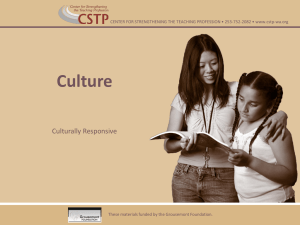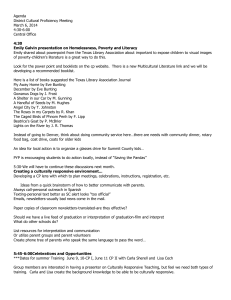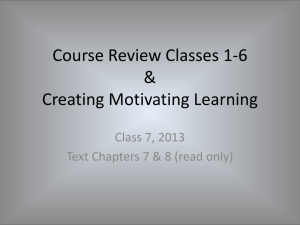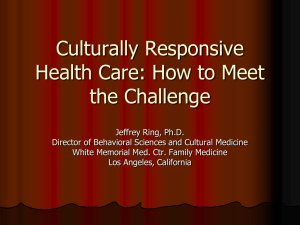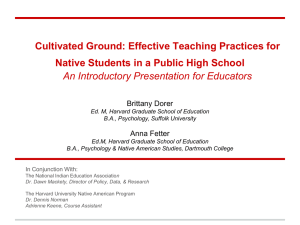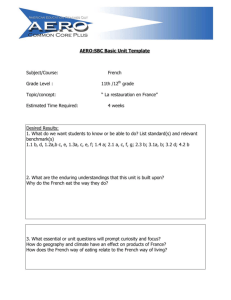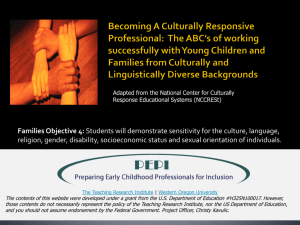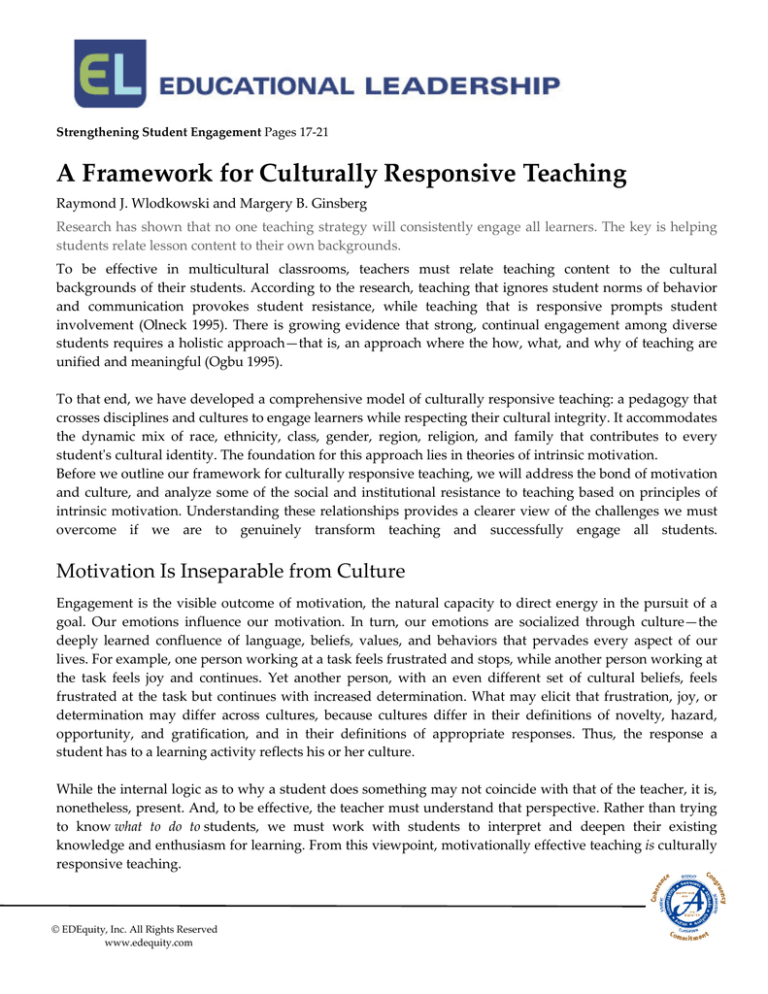
Strengthening Student Engagement Pages 17-21
A Framework for Culturally Responsive Teaching
Raymond J. Wlodkowski and Margery B. Ginsberg
Research has shown that no one teaching strategy will consistently engage all learners. The key is helping
students relate lesson content to their own backgrounds.
To be effective in multicultural classrooms, teachers must relate teaching content to the cultural
backgrounds of their students. According to the research, teaching that ignores student norms of behavior
and communication provokes student resistance, while teaching that is responsive prompts student
involvement (Olneck 1995). There is growing evidence that strong, continual engagement among diverse
students requires a holistic approach—that is, an approach where the how, what, and why of teaching are
unified and meaningful (Ogbu 1995).
To that end, we have developed a comprehensive model of culturally responsive teaching: a pedagogy that
crosses disciplines and cultures to engage learners while respecting their cultural integrity. It accommodates
the dynamic mix of race, ethnicity, class, gender, region, religion, and family that contributes to every
student's cultural identity. The foundation for this approach lies in theories of intrinsic motivation.
Before we outline our framework for culturally responsive teaching, we will address the bond of motivation
and culture, and analyze some of the social and institutional resistance to teaching based on principles of
intrinsic motivation. Understanding these relationships provides a clearer view of the challenges we must
overcome if we are to genuinely transform teaching and successfully engage all students.
Motivation Is Inseparable from Culture
Engagement is the visible outcome of motivation, the natural capacity to direct energy in the pursuit of a
goal. Our emotions influence our motivation. In turn, our emotions are socialized through culture—the
deeply learned confluence of language, beliefs, values, and behaviors that pervades every aspect of our
lives. For example, one person working at a task feels frustrated and stops, while another person working at
the task feels joy and continues. Yet another person, with an even different set of cultural beliefs, feels
frustrated at the task but continues with increased determination. What may elicit that frustration, joy, or
determination may differ across cultures, because cultures differ in their definitions of novelty, hazard,
opportunity, and gratification, and in their definitions of appropriate responses. Thus, the response a
student has to a learning activity reflects his or her culture.
While the internal logic as to why a student does something may not coincide with that of the teacher, it is,
nonetheless, present. And, to be effective, the teacher must understand that perspective. Rather than trying
to know what to do to students, we must work with students to interpret and deepen their existing
knowledge and enthusiasm for learning. From this viewpoint, motivationally effective teaching is culturally
responsive teaching.
© EDEquity, Inc. All Rights Reserved
www.edequity.com
Locked in Mid-Century
Most educators with whom we have worked would agree that there is a strong relationship between culture
and motivation, and that it only makes sense to understand a student's perspective. Why, then, do we have
such difficulty acting this way in the classroom?
One major reason is that we feel very little social pressure to act otherwise. The popular media and
structural systems of education remain locked in a deterministic, mechanistic, and behaviorist orientation
toward human motivation.
If one were to do a content analysis of national news broadcasts and news magazines for the last 40 years to
identify the most widely used metaphor for motivation, “the carrot and the stick”—reward and punish,
manipulate and control—would prevail. As a result, our national consciousness assumes there are many
people who need to be motivated by other people.
The prevailing question, “How do I motivate them?” implies that “they” are somehow dependent,
incapable of self-motivation, and in need of help from a more powerful “other.” In this sense, the “at-risk”
label acts to heighten our perception of students as motivationally dysfunctional, and increases our
tendency not to trust their perspective. The fact that an inordinately high number of “at-risk” students are
poor and people of color should cause us to reflect on how well we understand motivation. Thoughtful
scholars have suggested that this label now serves as a euphemism for “culturally deprived” (Banks 1993).
Secondary education is influenced a great deal by the practices of higher education, and both levels tend to
follow the precepts of extrinsic reinforcement. Teaching and testing practices, competitive assessment
procedures, grades, grade point averages, and eligibility for select vocations and colleges form an
interrelated system. This system is based on the assumption that human beings will strive to learn when
they are externally rewarded for a specific behavior or punished for lack of it.
Schools and colleges successfully educate a disproportionately low number of low-income and ethnic
minority students (Wlodkowski and Ginsberg 1995). Because the importance of grades and grade point
averages increases as a student advances in school, it is legitimate to question whether extrinsic motivation
systems are effective for significant numbers of students across cultures. We can only conclude that, as long
as the educational system continues to relate motivation to learn with external rewards and punishments,
culturally different students will, in large part, be excluded from engagement and success in school.
Changing Consciousness About Motivation
It is part of human nature to be curious, to be active, to initiate thought and behavior, to make meaning
from experience, and to be effective at what we value. These primary sources of motivation reside in all of
us, across all cultures. When students can see that what they are learning makes sense and is important,
their intrinsic motivation emerges.
© EDEquity, Inc. All Rights Reserved
www.edequity.com
We can begin to replace the carrot and stick metaphor with the words “understand” and “elicit”; to change
the concept of motivation from reward and punishment to communication and respect. We can influence
the motivation of students by coming to know their perspective, by drawing forth who they naturally and
culturally are, and by seeing them as unique and active. Sharing our resources with theirs, working
together, we can create greater energy for learning.
Intrinsic systems of motivation can accommodate cultural differences. Theories of intrinsic motivation have
been successfully applied and researched in areas such as cross-cultural studies (Csikszentmihalyi and
Csikszentmihalyi 1988); bilingual education (Cummins 1986); and education, work, and sports (Deci and
Ryan 1985). Ample documentation across a variety of student and regional settings suggests that
noncompetitive, informational evaluation processes are more effective than competitive, controlling
evaluation procedures (Deci et al. 1991, Deci and Ryan 1991).
A growing number of educational models, including constructivism and multiple intelligences theory, are
based on intrinsic motivation. They see student perspective as central to teaching. Unfortunately, educators
must often apply these theories within educational systems dominated by extrinsic reinforcement, where
grades and class rank are emphasized. And, when extrinsic rewards continue to be the primary motivators,
intrinsic motivation is dampened. Those students whose socialization accommodates the extrinsic approach
surge ahead, while those students—often the culturally different—whose socialization does not, fall behind.
A holistic, culturally responsive pedagogy based on intrinsic motivation is needed to correct this imbalance.
An Intrinsic Motivational Framework
We propose a model of culturally responsive teaching based on theories of intrinsic motivation. This model
is respectful of different cultures and is capable of creating a common culture that all students can accept.
Within this framework, pedagogical alignment—the coordination of approaches to teaching that ensure
maximum consistent effect—is critical. The more harmonious the elements of teaching are, the more likely
they are to evoke, encourage, and sustain intrinsic motivation.
The framework names four motivational conditions that the teacher and students continuously create or
enhance. They are:
1. Establishing inclusion—creating a learning atmosphere in which students and teachers feel respected
by and connected to one another.
2. Developing attitude—creating a favorable disposition toward the learning experience through personal
relevance and choice.
3. Enhancing meaning—creating challenging, thoughtful learning experiences that include student
perspectives and values.
4. Engendering competence—creating an understanding that students are effective in learning something
they value.
These conditions are essential to developing intrinsic motivation. They are sensitive to cultural differences.
They work in concert as they influence students and teachers, and they happen in a moment as well as over
a period of time.
© EDEquity, Inc. All Rights Reserved
www.edequity.com
Figure 1. Four Conditions Necessary for Culturally Responsive Teaching
1. Establish Inclusion
Norms:
• Emphasize the human purpose of what is being learned and its relationship to the students' experience.
• Share the ownership of knowing with all students.
• Collaborate and cooperate. The class assumes a hopeful view of people and their capacity to change.
• Treat all students equitably. Invite them to point out behaviors or practices that discriminate.
Procedures: Collaborative learning approaches; cooperative learning; writing groups; peer teaching; multidimensional sharing; focus groups; and reframing.
Structures: Ground rules, learning communities; and cooperative base groups.
2. Develop Positive Attitude
Norms:
• Relate teaching and learning activities to students' experience or previous knowledge.
• Encourage students to make choices in content and assessment methods based on their experiences, values,
needs, and strengths.
Procedures: Clear learning goals; problem solving goals; fair and clear criteria of evaluation; relevant learning
models; learning contracts; approaches based on multiple intelligences theory, pedagogical flexibility based on
style, and experiential learning.
Structure: Culturally responsive teacher/student/parent conferences.
3. Enhance Meaning
Norms:
• Provide challenging learning experiences involving higher order thinking and critical inquiry. Address
relevant, real-world issues in an action-oriented manner.
• Encourage discussion of relevant experiences. Incorporate student dialect into classroom dialogue.
Procedures: Critical questioning; guided reciprocal peer questioning; posing problems; decision making;
investigation of definitions; historical investigations; experimental inquiry; invention; art; simulations; and case
study methods.
Structures: Projects and the problem-posing model.
4. Engender Competence
Norms:
• Connect the assessment process to the students' world, frames of reference, and values.
• Include multiple ways to represent knowledge and skills and allow for attainment of outcomes at
different points in time.
• Encourage self-assessment.
Procedures: Feedback; contextualized assessment; authentic assessment tasks; portfolios and process-folios; tests
and testing formats critiqued for bias; and self-assessment.
Structures: Narrative evaluations; credit/no credit systems; and contracts for grades.
Based on Wlodkowski, R. J., and M. B. Ginsberg. (1995). Diversity and Motivation: Culturally Responsive Teaching.
San Francisco: Jossey-Bass.
© EDEquity, Inc. All Rights Reserved
www.edequity.com
References
Banks, J. A. (1993). “Multicultural Education: Historical Development, Dimensions, and Practice.” InReview of Research in Education,
Vol. 19, edited by L. Darling-Hammond. Washington, D.C.: American Educational Research Association.
Csikszentmihalyi, M., and I. S. Csikszentmihalyi. (1988). Optimal Experience: Psychological Studies of Flow in Consciousness. New York:
Cambridge University Press.
Cummins, J. (1986). “Empowering Minority Students: A Framework for Intervention.” Harvard Educational Review 56, 1: 18–36.
Deci, E. L., and R. M. Ryan. (1991). “A Motivational Approach to Self: Integration in Personality.” InNebraska Symposium on
Motivation: Vol. 38. Perspectives on Motivation, edited by R. Dienstbier. Lincoln: University of Nebraska Press.
Deci, E. L., and R. M. Ryan. (1985). Intrinsic Motivation and Self-Determination in Human Behavior. New York: Plenum.
Deci, E. L., R. J. Vallerand, L. C. Pelletier, and R. M. Ryan. (1991). “Motivation and Education: The Self-Determination
Perspective.” Educational Psychologist 26, 3 and 4: 325–346.
Ogbu, J. U. (1995). “Understanding Cultural Diversity and Learning.” In Handbook of Research on Multicultural Education, edited by J.
A. Banks and C. A. M. Banks. New York: Macmillan.
Olneck, M. R. (1995). “Immigrants and Education.” In Handbook of Research on Multicultural Education, edited by J. A. Banks and C. A.
M. Banks. New York: Macmillan.
Wlodkowski, R. J., and M. B. Ginsberg. (1995). Diversity and Motivation: Culturally Responsive Teaching. San Francisco: Jossey-Bass.
Raymond J. Wlodkowski is an Educational and Psychological Consultant, 6033 Jay Rd., Boulder, CO 80301.Margery B. Ginsberg is
Research Associate, RMC Research Corporation, Writer Square, Ste. 540, 1512 Larimer St., Denver, CO 80202.
© EDEquity, Inc. All Rights Reserved
www.edequity.com
Article Reflection Sheet
Please record the following reflections from the article:
3 things you learned (or re-learned)
●
●
●
2 things you plan to discus with your colleagues to improve teacher practice
●
●
1 Strategy you are committed to implementing from the article
●
Copyright © EDEquity, Inc. All Rights Reserved
www.edequity.com
Collaborative Conference for
Student Achievement 2016
The Elephant in the Room:
Refining Cultural Responsiveness
March 23, 2016
Presented by Frances W. McDonald
Senior Instructional Associate, EDEquity
Equity means…
Applying different or additional resources
*human
*fiscal
*intellectual
to ensure ALL students receive what they
need to exceed rigorous content standards.
Copyright © EDEquity, Inc. All Rights Reserved
Educational Equity….
§ is the belief that quality instruction for all
students will be achieved when the results
of deliberate actions to close the racial,
income, linguistic, teaching, and learning
achievement gap becomes the driving
force of the organization; by having
unlimited expectations for top performing
and under-achieving groups.
Copyright © EDEquity, Inc. All Rights Reserved
1
Do We Have the “Will”
to Educate All Children
The knowledge and skills to educate all children already
exist. …
There are no pedagogical barriers to teaching and
learning when willing people are prepared and made
available to children.
If we embrace a will to excellence, we can deeply
restructure education in ways that will enable teachers
to release the full potential of all our children.
ASA G. Hilliard
What is Will?
Will:
that faculty of the mind which selects, at
the moment of decision, the strongest
desire from among the various desires
present. Will does not refer to any
particular desire, but rather to the capacity
to act decisively on one’s desires.
Copyright © EDEquity, Inc. All Rights Reserved
Understanding Equity
To understand the impact of race and
culture on student achievement, you need
to be willing to abandon the belief that
colorblindness is a possible solution.
Equity Based Instructional Leaders are
Color Conscious.
Copyright © EDEquity, Inc. All Rights Reserved
2
What is Culture?
Culture:
the characteristics and knowledge of a
particular group of people; defined by
everything from language, religion,
cuisine, social habits, music and arts.
Copyright © EDEquity, Inc. All Rights Reserved
Looking Deeper…
The Center for Advance Research on
Language Acquisition goes further,
defining culture as:
“ shared patterns of behaviors and
interactions, cognitive constructs and
understanding that are learned by
socialization.”
Thus leading to “social patterns unique to
the group.”
Copyright © EDEquity, Inc. All Rights Reserved
Culture is to humans,
as water is to fish!
Dr. Wade Nobles
Copyright © EDEquity, Inc. All Rights Reserved
3
Making Cultural Connections
Copyright © EDEquity, Inc. All Rights Reserved
Fresh & Salt Water Fish
Learning Style Valued by
Standard English Learners &
English Language Learners
Learning Style Valued by
School Culture
(Fresh water environment)
§
§
§
§
§
§
§
§
§
Deductive (part to whole) ,
Controlled, Egocentric
Low-movement Expressive
Context
View Environment in Isolated
Parts
Precise Concepts of Space,
Number, and Time
Respond to Object Stimulus
Dominant Communication is
Verbal
Long Attention Span
Emphasis on Independent Work
Cognitive
(Salt water fish)
§
§
§
§
§
§
§
§
§
Inductive (whole to part) , Expressive,
Sociocentric
High-movement Expressive
Context
View Environment as a Whole
Approximate Concepts of Space,
Number, and Time
Respond to People/Social Stimulus
Non-Verbal & Verbal
Communication
Shorter Attention Span
Responds to Collaborative Efforts
Cognitive/Affective
Culturally Conscious Teaching Principles
Getting below the surface
Copyright © EDEquity, Inc. All Rights Reserved
4
Closing the Achievement Gap
75% Mind-set
(what I believe)
25% Instructional Strategies
(What I do)
Copyright © EDEquity, Inc. All Rights Reserved
5 Key Principles of Equity
§
§
§
§
§
Awareness
Attitude
Analysis
Action
Accountability
Copyright © EDEquity, Inc. All Rights Reserved
Awareness
Support educators in becoming more
culturally aware of the students and the
community they serve, and how that
awareness supports culturally conscious
schools and classroom instruction.
Copyright © EDEquity, Inc. All Rights Reserved
5
Attitude
Enhance the high expectations of
educators for all students to reach their
maximum potential which will transform
the educators’ attitudes into positive
behaviors and practices.
Copyright © EDEquity, Inc. All Rights Reserved
Analysis
Provide in-depth analysis (quantitatively and
qualitatively) of policies, procedures, practices,
and pedagogies that enhance the level of equitybased decision making in the districts, school sites,
and classrooms to meet the needs of every student.
Deep analysis of one’s personal racial identity
development and how the educators connect
instructional practice with student empowerment.
Copyright © EDEquity, Inc. All Rights Reserved
Action
Take action by implementing equity-based
and culturally conscious instructional
strategies and support structures that are
data driven to ensure that equality in
reaching grade level standards is achieved
for all students.
Copyright © EDEquity, Inc. All Rights Reserved
6
Accountability
Implement and restore accountability
systems and measures to ensure all
educators and community stakeholders
are held accountable and are actively
involved in creating equity-based
environments for all students to exceed
achievement and performance targets.
Copyright © EDEquity, Inc. All Rights Reserved
Article reflection
§ Culturally Responsive Framework
Copyright © EDEquity, Inc. All Rights Reserved
4 A’s Article Critique
§ As you read Culturally Responsive Framework;
consider the following:
§ What Assumptions does the author of the text
hold?
§ What do you Agree with in the text?
§ What do you want to Argue with the text?
§ What part of the text do you wish to Aspire
to?
Copyright © EDEquity, Inc. All Rights Reserved
7
Information does not mean transformation!
Anthony Muhammad
Copyright © EDEquity, Inc. All Rights Reserved
Culturally Conscious Instruction
Is an instructional concept that requires educators
to be purposeful, intentional and deliberate in
instructional planning, designing and delivery of
instruction. Teachers are aware of how students
make meaning of text through their cultural and
linguistic experiences.
Through this understanding, collaborative
planning of standards - based lessons/activities are
produced and implemented. (Vygotsky, L.S. 1929;
Gay 2003).
Copyright © EDEquity, Inc. All Rights Reserved
Conditions for Culturally Conscious
Teaching
§ Establishing inclusion—creating a learning atmosphere
in which students and teachers feel respected by and
connected to one another.
§ Developing attitude—creating a favorable disposition
toward the learning experience through personal
relevance and choice.
§ Enhancing meaning—creating challenging, thoughtful
learning experiences that include student perspectives
and values.
§ Engendering competence—creating an understanding
that students are effective in learning something they
value.
Copyright © EDEquity, Inc. All Rights Reserved
8
Culturally Conscious
Lesson Design
When using Culturally Conscious Direct Instruction (CCDI) as the
framework for planning, the teacher increases his/her effectiveness
when considering the following:
Content must come alive for the students, and offer appropriate
scaffolding to support the learning needs of all students.
“Decide, then design” is the foundation on which all successful instruction is
built.
Ask yourself:
- What am I going to teach? (content)
- What do I know about my students to actively engage them throughout
the lesson? (student behavior)
- How am I going to teach it? (teacher behavior)
- How will I know that my students have learned it? (teacher reflection)
Copyright © EDEquity, Inc. All Rights Reserved
Culturally Conscious Planning
§ 4 essential questions while planning
culturally conscious lessons:
§ How do I add rigor to my learning objectives?
§ What vocabulary will students need know and use to engage the
learning objective?
§ How will I explicitly teach/model the instructional objectives to
ensure students have a clear understanding of what is expected
of them?
§ What will students need to demonstrate during the lesson to
exceed my expectations of the learning objective(s)?
Copyright © EDEquity, Inc. All Rights Reserved
ACTIVITY
§
School A – Success based upon student’s ability
§
§
School purpose is about ranking and sorting; ability is predetermined based on
students’ effort
School B – Students who take advantage of the opportunity for learning
are successful
§
I taught it and you did not get it; ownership for learning is placed on the
student
§
School C – Low expectations for students
§
§
§
1.
2.
3.
4.
We love our kids, I don’t want to damage their self-esteem with rigorous
instruction
School D – Will do “whatever it takes” to ensure students are successful
Professional Learning Community; School takes ownership of student learning
Which type of high school did you attend?
In which school do you currently work?
In which school do you want to work?
Which school would you want YOUR child or family member to attend?
Copyright © EDEquity, Inc. All Rights Reserved
9
Contact Information
Frances W. McDonald
Senior Instructional Associate, EDEquity, Inc.
1735 Technology Drive Ste. 420
San Jose, CA 95110
Toll Free 1-877-EDEQTY1 (333-7891)
Website: www.edequity.com
E-Mail: fmcdonald14@yahoo.com
Copyright © EDEquity, Inc. All Rights Reserved
10

